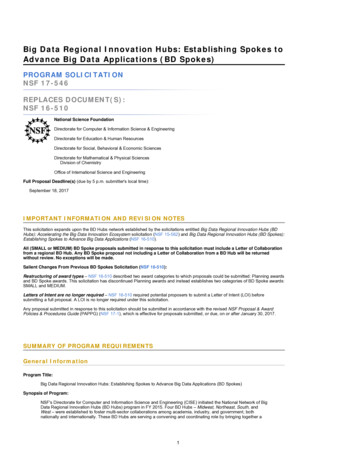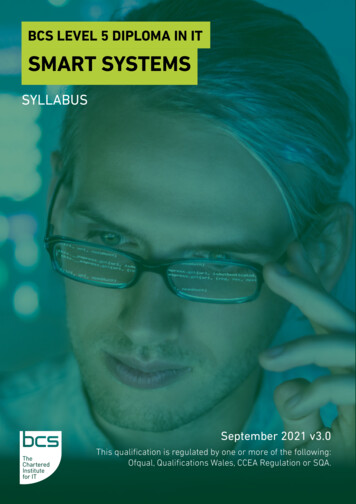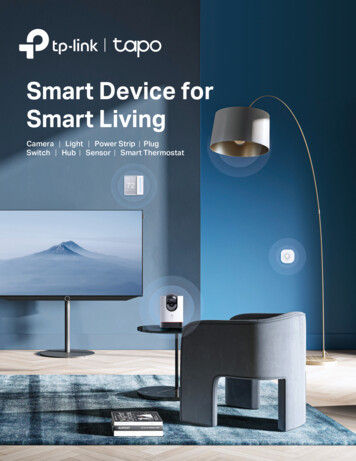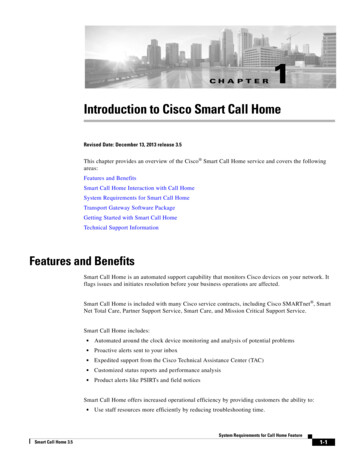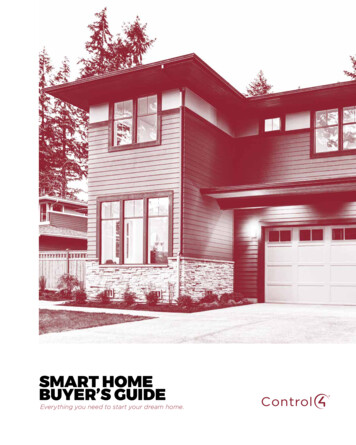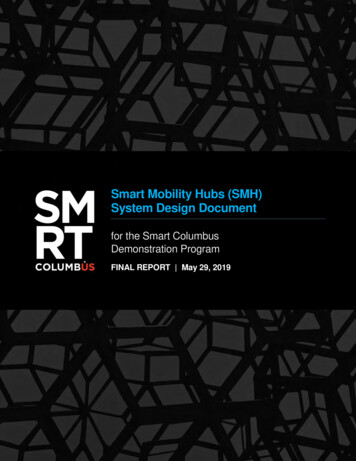
Transcription
Smart Mobility Hubs (SMH)System Design Documentfor the Smart ColumbusDemonstration ProgramFINAL REPORT May 29, 2019
Produced by City of ColumbusNoticeThis document is disseminated under the sponsorship of the Department of Transportationin the interest of information exchange. The United States Government assumes no liabilityfor its contents or use thereof.The U.S. Government is not endorsing any manufacturers, products, or servicescited herein and any trade name that may appear in the work has been includedonly because it is essential to the contents of the work.Acknowledgment of SupportThis material is based upon work supported by the U.S. Department ofTransportation under Agreement No. DTFH6116H00013.DisclaimerAny opinions, findings, and conclusions or recommendations expressed in thispublication are those of the Author(s) and do not necessarily reflect the view of theU.S. Department of Transportation.
Table of Contents1.1. Scope . 11.2. Context. 11.2.1.1.2.2.1.2.3.Design Traceability to User Needs . 2Requirements Traceability . 2System Interface Traceability . 21.3. Related Documents . 21.4. References . 32.1. Project Stakeholders . 52.2. Roles . 62.3. Responsibilities . 72.3.1.2.3.2.2.3.3.2.3.4.Deputy Program Manager . 7Project Manager. 8Design Engineer . 8Technical Lead . 92.4. Project Agreements . 93.1. Smart Mobility Hub Design Concerns . 114.1. Interactive Kiosks . 134.1.1.4.1.2.4.1.3.4.1.4.Traveler Information Subsystem . 15Emergency Call Button Subsystem . 26Wireless Internet Subsystem. 29Device Charging Subsystem . 314.2. Mobility Infrastructure . Ride-Share . 33Car-Share . 35Dockless Parking . 36Park and Ride . 37Bike-Share . 38Bike Racks. 40Automated Vehicle Shuttles. 41Electric Vehicle Charging Station . 41Smart Mobility Hubs System Design Document – Final Report Smart Columbus Program i
Table of Contents5.1. Columbus State Community College . 445.1.1.5.1.2.Miscellaneous Information . 44Columbus State Community College Location and Geometric Layout . 445.2. Linden Transit Center . 465.2.1.5.2.2.Miscellaneous Information . 46Location and Geometric Layout . 465.3. St. Stephen’s Community House . 485.3.1.5.3.2.Miscellaneous Information . 48Location and Geometric Layout . 485.4. Metro Library – Linden Branch . 515.4.1.5.4.2.Miscellaneous Information . 51Location and Geometric Layout . 515.5. Northern Lights Park and Ride . 535.5.1.5.5.2.Miscellaneous Information . 53Location and Geometric Layout . 535.6. Easton Transit Center. 555.6.1.Location and Geometric Layout . 556.1. Bike-share Docking Station. 576.2. USB Charging . 576.3. Car-Share, Park and Ride . 576.4. Emergency Call Button . 576.5. Signage . 576.6. Accessibility. 576.7. Interactive Kiosk. 586.8. Electric Vehicle Charging . 587.1. Project Objectives Review. 597.1.1.7.1.2.Mobility Objective . 59Customer Satisfaction Objective . 597.2. Future Project Enhancements . 60ii Smart Columbus Program Smart Mobility Hubs System Design Document – Final Report
Table of ContentsList of TablesTable 1: References . 3Table 2: Project Stakeholder Contact Information . 6Table 3: System Design Roles and Contact Information . 7Table 4: SMH Anticipated Agreements . 9Table 5: Smart Mobility Hub System Amenities . 12Table 6: Interactive Kiosk System Components. 18Table 7: Interactive Kiosk Data and Message Type . 20Table 8: Interactive Kiosk Hardware Components . 21Table 9: Emergency Call Button System Components . 27Table 10: Emergency Call Button Data and Message Type . 28Table 11: Emergency Call Button Hardware Components . 29Table 12: Wi-Fi System Components . 30Table 13: Wi-Fi Data and Message Type . 31Table 14: Wi-Fi Hardware Components . 31Table 15: USB Hardware Components . 33Table 16: SMH Mobility Objective . 59Table 17: SMH Customer Satisfaction Objective . 59Table 18: Traceability Matrix. 61Table 19: Acronyms List . 107Table 20: Glossary . 111Smart Mobility Hubs System Design Document – Final Report Smart Columbus Program iii
Table of ContentsList of FiguresFigure 1: IK Physical Model . 14Figure 2: IK Custom Branding Options . 15Figure 3: IK Traveler Information System Design . 16Figure 4: Interactive Kiosk System Applications . 17Figure 5: Interactive Kiosk Foundation Design . 23Figure 6: ADA Pedestrian Accessibility (Ground Space Position to Kiosk). 24Figure 7: Standard USB Plug Design (Dual Architecture for Low and Super Speed) . 32Figure 8: Generic Ride-Share System Design . 34Figure 9: Project Scope Area Along Cleveland Corridor . 43Figure 10: Planned Design for the Columbus State Community College Mobility Hub . 45Figure 11: Planned Design for the Linden Transit Center Mobility Hub . 47Figure 12: Planned Design for St. Stephen’s Community House Mobility Hub . 50Figure 13: Planned Design for the Metro Library – Linden Branch Mobility Hub. 52Figure 14: Planned Design for the Northern Lights Park and Ride Mobility Hub. 54Figure 15: Planned Design for the Easton Transit Center Mobility Hub . 55iv Smart Columbus Program Smart Mobility Hubs System Design Document – Final Report
Introduction1.1.SCOPEThe Smart Columbus Smart Mobility Hubs (SMH) project is one of eight projects in the Smart Columbusprogram and is considered the future of consolidated transportation centers. The project is scoped to deploya number of transportation amenities at six different facilities. These amenities work together to delivermobility as a service (MaaS) providing travelers with new and consolidated transportation options to moveabout the region using various modes.SMH will deploy interactive kiosks (IK), which will provide access to Comprehensive Trip Planning (CTP)services including the Multimodal Trip Planning Application (MMTPA) with a centralized Common PaymentSystem (CPS), real-time transportation data for various modes, call button for emergency services, Wi-Fiinternet access, USB charging, notifications/advisories, and local event information. The facilities are alsodesigned to accommodate multiple modes of transportation from a single location including bike-share, carshare, and scooter-share, while facilitating pick-up/drop-off points for mobility providers. These services areparticularly useful in the completion of first-mile/last-mile (FMLM) and multimodal trip options.The purpose of this System Design Document (SDD) is to describe the system design in detail tostakeholders interested in design implementation details. The intended audience for this SDD includes theCity of Columbus project team, United States Department of Transportation (USDOT), vendor developmentteams, product owners, and technical and managerial stakeholders with an interest in the SMH designspecifications. The document may also be used as a resource by future transportation mobility projects andstate DOTs designing and deploying smart mobility hub amenities.The SDD framework has been adopted from IEEE Std 1016TM-2009 (Revision of IEEE Std 1016-1998)IEEE Standard for Information Technology –– Systems Design –– Software Design Descriptions andincludes descriptions for hardware and software.1.2.CONTEXTThis document is composed of four primary parts. The first part introduces the concepts for the SMH systemas a whole by discussing project stakeholders and SMH design concerns. The next segment presents ahigh-level summary of each amenity along with the capability it offers travelers within the scope of theproject. Thereafter, detailed design elements are presented per amenity from the viewpoint of the technicalproduct (e.g., IT, software engineering, communications, etc.) in terms of system software and hardwarecomponents. For each SMH amenity, a technical product-specific design view will be presented, asapplicable (note, design elements in Chapter 4 apply to all sites independent of installation location): Amenity name and description Software system Services System components Data and message flows Network and communications Hardware components Interface traceabilitySmart Mobility Hubs System Design Document – Final Report Smart Columbus Program 1
Chapter 1. Introduction Requirements traceabilityHardware Design structure Physical loads and forces MaterialsFinally, the fourth segment presents a description of each SMH facility (i.e., mobility hub) from the viewpointof the business owner as it relates to the construction planned for that location.For each SMH facility outlined in Chapter 5 the location-specific amenities along with the uniqueengineering and construction views for that location will be presented in the following format, as applicable: SMH facility name and description Location, planned amenities, and geometric layout Structure design Miscellaneous (utilities, lighting, signage, drainage)1.2.1.Design Traceability to User NeedsThis SDD also provides traceability back to user needs, requirements, and SMH system interfaces. Userneeds captured in the project Concept of Operations (ConOps) are expressed in terms of capability (lacking)or needing the ability to (action verb – perform, capture, do, review, etc.) some “articulated need”. As such,user needs are tied to, and addressed by, the Service(s) each amenity provides (Service is a labeled headerherein) – as the outcome of each Service delivers a (new) system capability.1.2.2.Requirements TraceabilitySystem requirements for the SMH project were established through the SyRS and for the most part, theyare traced to design elements in the “System Components” section(s), respectively. These sections definehow the component is designed (physically and logically) and the requirement identifier traced can beprimarily found within the system component tables, in the “Reference” column; however, some requirementidentifiers can also be found in other areas of the document as appropriate, when the design element that isbeing defined is a result of a requirement.1.2.3.System Interface TraceabilityA number of amenities that are part of the current SMH project do not require data, network andcommunications, or perhaps are not instrumented for data collection at the time of SMH design. However,for those amenities that do require data flows (and thus network communications) as part of the servicedesign, the system interface(s) has been traced. Note that specific data element details per interface isappropriately captured by the SMH Interface Control Document (ICD) and therefore, not detailed quite as indepth within this SDD. System interface traceability has been captured in the Data and Message Flowsection of each subsystem.1.3.RELATED DOCUMENTSThe SMH design is constructed to meet the user needs and features identified in the SMH ConOps andmeet the requirements established in the System Requirements (SyRS). It is also supported by the InterfaceControl Document (ICD) which provides a detailed description of the internal and external interfaces for the2 Smart Columbus Program Smart Mobility Hubs System Design Document – Final Report
Chapter 1. IntroductionSMH project and the data, information, and messages that are communicated across those interfaces. Thedesign is built upon the architecture described in the Smart Columbus System Architecture and StandardsPlan (SASP) and provides traceability of requirements from user needs through design. Concept of Operations for Smart Mobility Hubs for the Smart Columbus Demonstration Program System Requirements for Smart Mobility Hubs for the Smart Columbus Demonstration Program Smart Mobility Hubs Interface Control Document for the Smart Columbus Demonstration Program System Architecture and Standards Plan for the Smart Columbus Demonstration ProgramThese documents are available from the digital document library on the Smart Columbus project site at:https://smart.columbus.gov/projects/. A copy of these documents can also be obtained by sending a requestto: City of Columbus, Attn: Department of Public Service, 111 N. Front St., Columbus, OH 43215.1.4.REFERENCESTable 1 contains documents, literature, and working group sessions used to gather input for this document.Table 1: ReferencesDoc. No.TitleRev.Pub. DateFHWA-JPO-17518Smart Columbus Systems Engineering ManagementPlan (SEMP) for Smart Columbus /dot/34764–Jan. 16, 20181016-2009IEEE Standard for Information Technology – SystemsDesign – Software Design .2INCOSE Systems Engineering Handbook3.2.22011–Systems Engineering Guidebook for IntelligentTransportation Systems3.02009N/AN/A–Smart Columbus Operating Systemhttps://www.smartcolumbusos.com–Concept of Operations for Smart Mobility Hubs for theSmart Columbus Demonstration Program–System Requirements for Smart Mobility Hubs for theSmart Columbus Demonstration ProgramN/A2018–Smart Mobility Hubs Interface Control Document for theSmart Columbus Demonstration ProgramN/A2019–System Architecture and Standards Plan for the SmartColumbus Demonstration ProgramN/A–1851-ACity of Columbus, Ohio; Department of Public Service;Division of Design and Construction; Smart MobilityHubs Standard Construction DrawingsStage 3Submittal–2018Source: City of ColumbusSmart Columbus Program Smart Mobility Hubs System Design Document – Final Report 3
System StakeholdersSystem design can cross many different groups within an organization to ensure requirements are gatheredand met for all stakeholders. As such, the roles and responsibilities section is included to provide clarity tothe team on who performs various roles. This section also includes a list of points of contact for the teamand stakeholders to use should issues or concerns arise.2.1.PROJECT STAKEHOLDERS1. City of Columbus – Owner of the SMH project through the Smart Columbus Program.2. Central Ohio Transit Authority (COTA) – COTA is the Columbus area transit leader and a stakeholder tothe SMH project as the regional transit authority and as the site owner for three SMH installations.3. Columbus State Community College (CSCC) – The CSCC campus surrounds downtown Columbus’southernmost SMH location. While the SMH will be located completely in the right-of-way (ROW),coordination is essential as many development projects are being completed in the area.4. Columbus Metropolitan Library (CML) – The CML exists in 23 locations throughout Franklin County. TheLinden Library location on Cleveland Avenue is the site for one SMH location.5. St. Stephen’s Community House – St. Stephen’s has been a community gathering place for 100 yearsand offers services including childcare, youth, family, and senior services. St. Stephens is an SMHlocation that will offer all SMH services on its property, including the kiosk inside the building.6. City of Columbus 911 Call Center and Police Department – The City’s 911 Call Center will be the publicsafety answering point that is responsible for responding to the activation of five of the kiosk’semergency buttons. The City’s 911 Call Center will dispatch the call to the Columbus PoliceDepartment.7. Franklin County Sheriff’s Office – The county’s Sheriff’s Office could be one of three respondingagencies at the Northern Lights SMH location. The location of the kiosk is within the City limits, but theClinton Township line is within eyesight of the kiosk and it is conceivable that someone could push theemergency button for an incident within the Township. Therefore, the Franklin County Sheriff’s Officedispatch the Clinton Township Police Department for emergency call button activations at NorthernLights SMH.8. Clinton Township Police Department – The Northern Lights location in located both in the City ofColumbus and Clinton Township and therefore, the Clinton Township Police Department will be the firstresponding agency to the County’s 911 Call Center dispatch for this location.9. Mobility Providers – Mobility providers will have their services present at the SMH locations. Eachlocation will have a select number of services based on the space allowable and through coordinationwith each of the property stakeholders. Mobility providers will include companies with the followingservices: bus transit service, dockless bikes and scooters, car-share, ride-share, bike-share, and AVshuttle.10. Experience Columbus – Experience Columbus, Columbus’ tourism agency, holds a contract with IKESmart City for the deployment of kiosks in the Columbus region. Experience Columbus has beenassisting the Smart Columbus team in understanding the needs of residents and visitors wheninteracting with a kiosk. Experience Columbus has offered to contract for and manage the six kiosksthat will be located at the SMH.Smart Mobility Hubs System Design Document – Final Report Smart Columbus Program 5
Chapter 2. System Stakeholders11. Orange Barrel Media – Orange Barrel Media is the owner of IKE Smart City, a software company thathas created an interactive kiosk to disseminate information to the public and allow for greater mobilityaround a city. Orange Barrel Media has an agreement with the City to deploy kiosks in the public rightof-way and will be deploying kiosks as part of this project.The following table provides the role and contact information for the key technical and project stakeholdersassociated with the system design.Table 2: Project Stakeholder Contact InformationNameRoleEmail AddressMichael StevensExecutive Sponsor, Smart Columbusmhstevens@columbus.govAndrew WolpertSmart Columbus Deputy Program Manageradwolpert@columbus.govAndrew KistlerDirector of Property Management at ColumbusMetropolitan Libraryakistler@columbuslibrary.orgLora KnightProperty Management at the ColumbusMetropolitan Library – Linden Branchlknight@columbuslibrary.orgMarilyn MehaffieChief Executive Officer, St. Stephen’s Leadmmehaffie@saintstephensch.orgTommy FergusonEducation Coordinator at St. Stephen’sCommunity Housetferguson@saintstephensch.orgRefai BassamCOTA Construction Project Managerrefaib@cota.comRobb CoventryDirector of Facilities at Columbus StateCommunity Collegercoventry@cscc.eduKori FowlerDevelopment Manager at Orange Barrel Mediaand IKE Smart Citykfowler@ikesmartcity.comSource: City of Columbus2.2.ROLESSMH is designed to serve the needs of many different types of users, with features and functionsappropriate for each one. Different amenities are offered at the SMH location based on available space. Thissection will outline the features and functions at a high level for SMH stakeholders. Travelers are individuals in need of transportation services. Transportation services will include: Car-Share Ride-Share Bike-Share Bike Parking Dockless Device Parking Park and Ride Transit and Paratransit Autonomous Shuttle Interactive Kiosk with Multimodal Trip Planning Application6 Smart Columbus Program Smart Mobility Hubs System Design Document – Final Report
Chapter 2. System Stakeholders Electric Vehicle Charging MMTPA Users are individuals who want to use the MMTPA application to plan their trip. Travelers havea user account and travel profile, while anonymous travelers do not have an account and can use thesystem without login. This application can be accessed on a personal device or the interactive kiosk. Interactive Voice Response (IVR) Users are individuals without a Wi-Fi enabled device and needtelephone-based assistance to plan, schedule, or pay for their trip. Provider Administrators are representatives of organizations that provide transportation services, whoneed to manage and maintain assets and information on the services they provide. System Administrators are the “super-users” who manage and maintain the software. At this time, thevendors awarded will perform this role and are responsible for maintaining sites and reporting systemstats to the City of Columbus project managers. Wi-Fi Users are individuals in need of Wi-Fi for internet access to assist with travel arrangements or forother personal reasons. The kiosk will provide Wi-Fi coverage. USB Users are individuals in need of charging their personal devices during multimodal trips. The kioskwill provide power to a USB charging pedestal.The City of Columbus will enter into partnership agreements with COTA, St. Stephen’s Community House,Columbus Metropolitan Library, and Columbus State Community College for the Smart Mobility Hubsproject. Each location may have different amenities which would require different installation and operationand maintenance agreements.Table 3 identifies the system design roles. This matrix also serves as the list of points of contact for issuesand concerns relating to the system design.Table 3: System Design Roles and Contact InformationNameRolePhoneEmailAndy WolpertCity of ColumbusDeputy Program Manager614-538-7601adwolpert@columbus.govJeff KupkoMichael Baker InternationalProject t GrafHNTB CorporationTechnical Lead,Design Engineer614-493-5516mgraf@hntb.comJess BakerHNTB CorporationTechnical and SystemsEngineer
The Smart Columbus Smart Mobility Hubs (SMH) project is one of eight projects in the Smart Columbus program and is considered the future of consolidated transportation centers. The project is scoped to deploy




